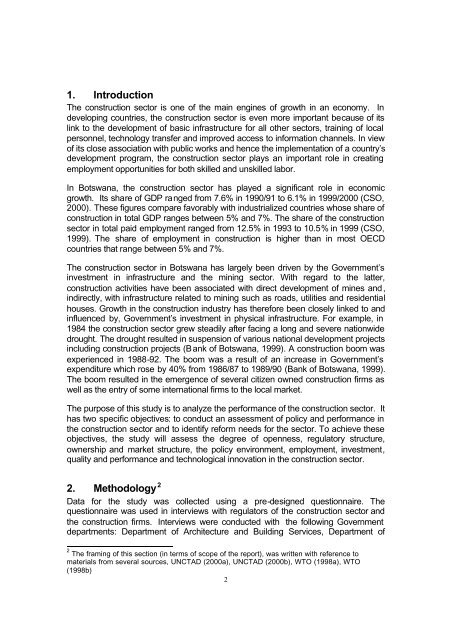Gape & Margaret - Botswana Construction WP No. 4 - tips
Gape & Margaret - Botswana Construction WP No. 4 - tips
Gape & Margaret - Botswana Construction WP No. 4 - tips
- No tags were found...
You also want an ePaper? Increase the reach of your titles
YUMPU automatically turns print PDFs into web optimized ePapers that Google loves.
1. IntroductionThe construction sector is one of the main engines of growth in an economy. Indeveloping countries, the construction sector is even more important because of itslink to the development of basic infrastructure for all other sectors, training of localpersonnel, technology transfer and improved access to information channels. In viewof its close association with public works and hence the implementation of a country’sdevelopment program, the construction sector plays an important role in creatingemployment opportunities for both skilled and unskilled labor.In <strong>Botswana</strong>, the construction sector has played a significant role in economicgrowth. Its share of GDP ranged from 7.6% in 1990/91 to 6.1% in 1999/2000 (CSO,2000). These figures compare favorably with industrialized countries whose share ofconstruction in total GDP ranges between 5% and 7%. The share of the constructionsector in total paid employment ranged from 12.5% in 1993 to 10.5% in 1999 (CSO,1999). The share of employment in construction is higher than in most OECDcountries that range between 5% and 7%.The construction sector in <strong>Botswana</strong> has largely been driven by the Government’sinvestment in infrastructure and the mining sector. With regard to the latter,construction activities have been associated with direct development of mines and,indirectly, with infrastructure related to mining such as roads, utilities and residentialhouses. Growth in the construction industry has therefore been closely linked to andinfluenced by, Government’s investment in physical infrastructure. For example, in1984 the construction sector grew steadily after facing a long and severe nationwidedrought. The drought resulted in suspension of various national development projectsincluding construction projects (Bank of <strong>Botswana</strong>, 1999). A construction boom wasexperienced in 1988-92. The boom was a result of an increase in Government’sexpenditure which rose by 40% from 1986/87 to 1989/90 (Bank of <strong>Botswana</strong>, 1999).The boom resulted in the emergence of several citizen owned construction firms aswell as the entry of some international firms to the local market.The purpose of this study is to analyze the performance of the construction sector. Ithas two specific objectives: to conduct an assessment of policy and performance inthe construction sector and to identify reform needs for the sector. To achieve theseobjectives, the study will assess the degree of openness, regulatory structure,ownership and market structure, the policy environment, employment, investment,quality and performance and technological innovation in the construction sector.2. Methodology 2Data for the study was collected using a pre-designed questionnaire. Thequestionnaire was used in interviews with regulators of the construction sector andthe construction firms. Interviews were conducted with the following Governmentdepartments: Department of Architecture and Building Services, Department of2The framing of this section (in terms of scope of the report), was written with reference tomaterials from several sources, UNCTAD (2000a), UNCTAD (2000b), WTO (1998a), WTO(1998b)2
















